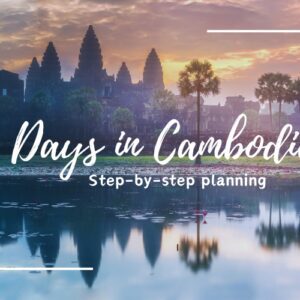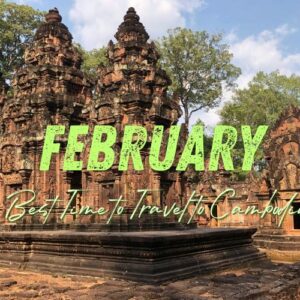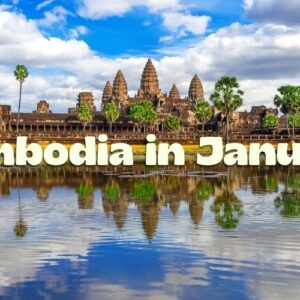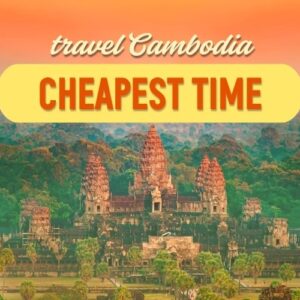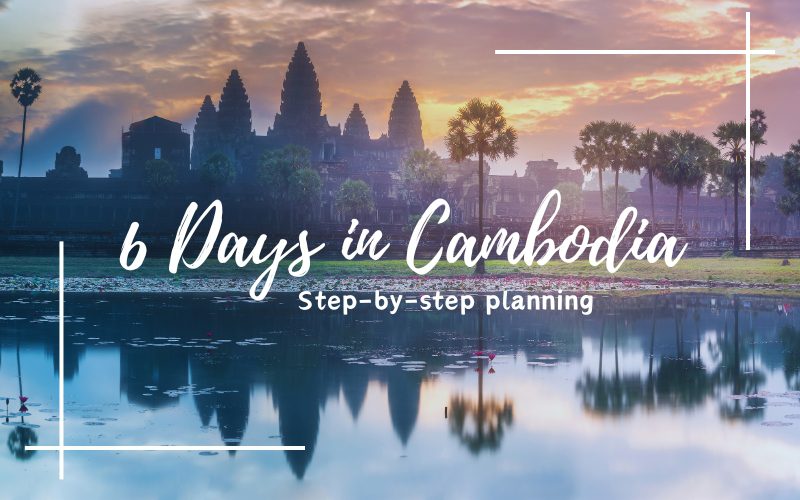
Embarking on a journey to Cambodia promises an adventure filled with rich history, breathtaking landscapes, and captivating culture. If you’re pondering over how to make the most of 6 days in Cambodia, look no further. This guide is meticulously crafted to help you navigate through the enchanting realms of Cambodia, ensuring that every moment of your trip is soaked in sheer delight and discovery.
The charm of Cambodia lies in its compact yet vibrant tapestry of experiences, from the mystical allure of ancient temples and the historical depth of its cities to the serene beauty of its coastlines. Despite its modest size, this country packs a punch with its diverse offerings that cater to every traveler’s whim. Planning a Cambodia 6-day itinerary might seem daunting at first, but rest assured, it’s simpler than it appears. With this step-by-step guide, you’ll unlock the secrets to a fulfilling journey through Cambodia, embracing everything this spectacular destination has to offer. Whether you’re a history buff, nature lover, or beachgoer, get ready to embark on a journey that promises an array of unforgettable experiences.
Step 1: Choose a Favorable Time
Visiting Cambodia offers a window into a world of ancient wonders, vibrant cultures, and breathtaking natural landscapes. The best time to visit this enchanting country largely depends on what you’re looking for in your travel experience.
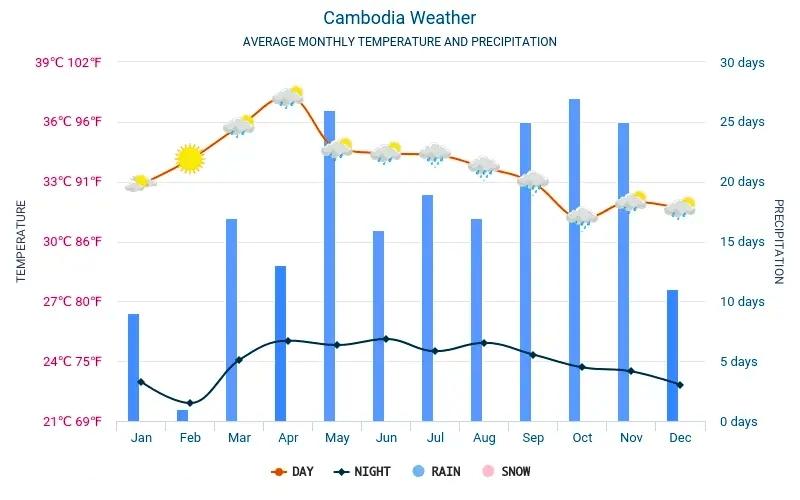
Cambodia weather
For those seeking the best weather, the dry season from November to February is ideal. During these months, Cambodia enjoys cool breezes and minimal rainfall, making it perfect for exploring the ancient temples of Angkor Wat, wandering through bustling markets, and enjoying the country’s stunning beaches. This period also offers clear skies and comfortable temperatures, ideal for outdoor adventures and cultural exploration.
However, if you want to avoid the crowds, consider visiting during the shoulder months of October and early November, or late February through March. These times offer a sweet spot where the weather remains fairly pleasant and the major tourist spots are less crowded. You’ll have a better chance of experiencing the serene beauty of Cambodia’s temples and natural attractions without the throngs of tourists, allowing for a more intimate exploration of the country’s rich heritage and landscapes.
In case you prefer to travel on a budget, the wet season, which runs from May to early October, presents an opportunity for lower prices and fewer tourists. Although this season brings heavy rainfall, the showers are often short-lived and can bring a refreshing respite from the heat. Accommodations and tours are generally cheaper during this period, and the landscape is lush and vibrant, offering a different perspective on Cambodia’s natural beauty. The rainforests are at their most lush, and the waterfalls swell and roar, presenting a majestic sight for those willing to brave the wetter conditions.
Step 2: Apply for Cambodia Visa
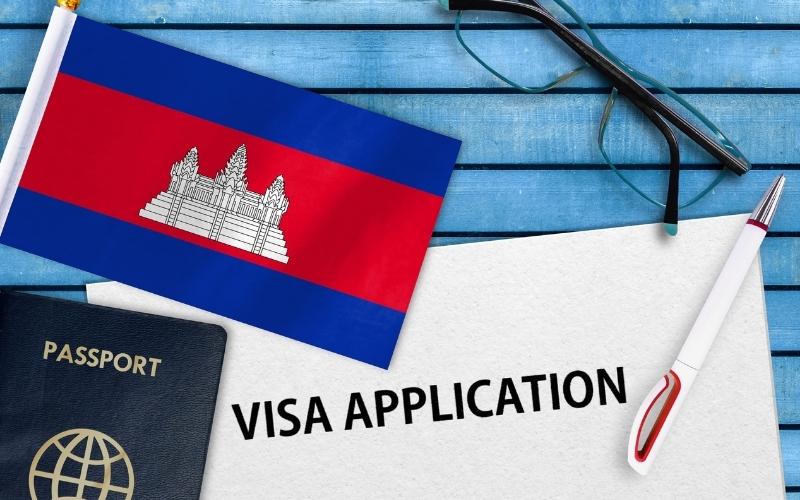
Cambodia visa
For almost all travelers heading to Cambodia, obtaining a tourist (T) visa is necessary. Visitors from countries such as Australia, the UK, Canada, South Africa, the USA, and Ireland are among those who must secure this visa, which carries a fee of USD 36 and remains valid for 30 days. It’s crucial to pay close attention to your designated entry and exit dates to avoid the legal ramifications of overstaying.
Citizens from a select group of countries, including Laos, Malaysia, the Philippines, Singapore, Vietnam, Thailand, Indonesia, Brunei, and Myanmar, are permitted to enter Cambodia without a tourist visa for stays varying between 21 to 30 days, depending on the specific country. So, if you are from these countries and plan to visit Cambodia in 6 days only, you don’t need to apply for a visa.
There are several ways for you to obtain a Cambodia visa:
- Opting for an E-Visa via an online application before your journey is advisable, with approval typically taking about 3 days.
- Acquiring a visa through a Cambodian Embassy or consulate abroad before you arrive in Cambodia.
- Many travelers can secure a visa upon their arrival at Phnom Penh, Sihanoukville, or Siem Reap International Airport. Those entering Cambodia via land from Thailand, Vietnam, or Laos might also obtain a visa at International Check Point borders, though it’s recommended to verify the visa issuance capabilities of your specific entry point beforehand.
- Certain nationalities, including those from Afghanistan, Algeria, Saudi Arabia, Bangladesh, Iran, Iraq, Pakistan, Sri Lanka, Sudan, and Nigeria, must apply for a visa through the Royal Embassy of the Kingdom of Cambodia in their home country before traveling.
Since visa requirements can change, it’s advisable to always verify the latest information before your trip.
Step 3: Decide Where to Go in Cambodia 6 Days
Phnom Penh
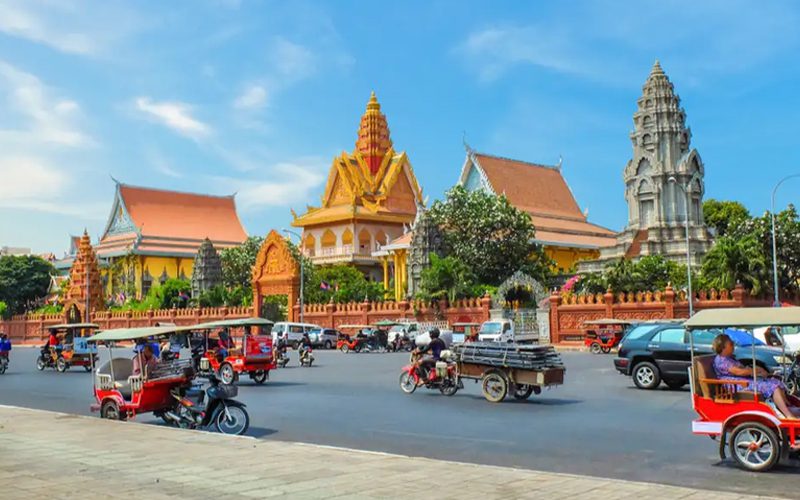
Phnom Penh
Phnom Penh, the vibrant capital of Cambodia, holds the distinction of being one of the country’s top destinations. Renowned not only as the heart of Cambodia, Phnom Penh narrates a tale of endurance, resilience, and rebirth that captivates all who visit. The city’s unique charm and the compelling story of its journey to becoming the ‘Pearl of Asia’ are evident to travelers delving into its rich layers.
The allure of Phnom Penh extends beyond its iconic temples and historical landmarks; its nightlife offers an equally captivating experience. Embarking on a Vespa scooter tour presents an extraordinary way to immerse in the city’s evening offerings. Starting at 6 PM and lasting four hours, this adventure allows visitors to explore key attractions like the bustling Mekong riverfront, navigate through local markets under the cover of night, and admire the Independence Monument, ensuring a comprehensive glimpse into the city’s vibrant night scene.
Siem Reap

Siem Reap
Nestled around the majestic Angkor Wat temple complex, this city radiates with ancient allure and historical significance, preserved over centuries. Home to over 400 temples, dedicate at least three days in Siem Reap to enhance your chances of experiencing many of these architectural marvels.
Beyond the spiritual monuments, the area is ripe with adventurous pursuits. To avoid temple fatigue, intersperse your temple visits with days of exploration in other realms of the city. Embarking on a Vespa tour is a splendid way to dive into the heart of Cambodian culture. These tours, beginning at 8 AM and concluding by lunchtime at 3 PM, offer a unique perspective of the city. The journey through cool breezes and past verdant landscapes of paddy fields promises an enchanting experience.
While the temples and Vespa tours highlight two significant aspects of Cambodia, the country’s islands, Kampot, and the renowned Bokor National Park offer additional avenues for exploration. Visiting elephant sanctuaries and indulging in Cambodia’s seafood specialties further enrich the travel experience, offering a taste of the diverse offerings beyond its major urban centers.
Tonle Sap Lake
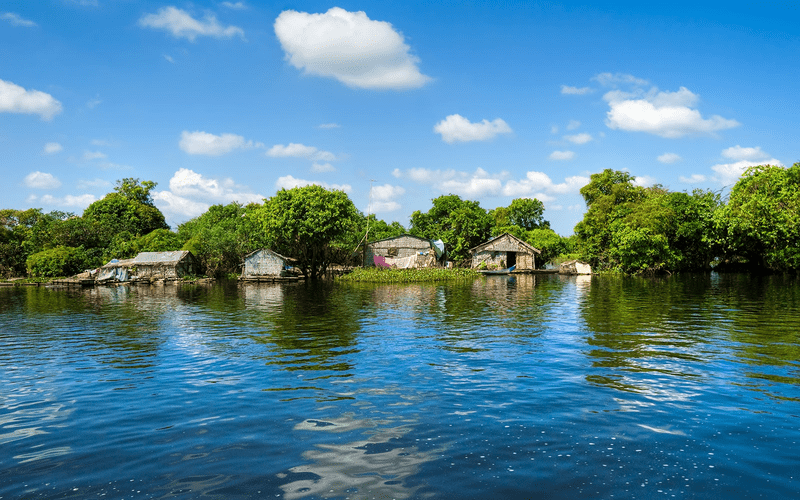
Tonle Sap Lake
Tonlé Sap, the lifeline of Cambodia and the largest freshwater lake in Southeast Asia plays a crucial role in the region. It not only serves as a key source of food but also supports Cambodian agriculture through irrigation. Remarkably, the lake sustains 170 floating communities, where the primary means of making a living is fishing, with entire homes and infrastructure established directly on the water.
The architecture of these floating villages is a spectacle in itself, with structures such as houses, marketplaces, places of worship, educational institutions, and community centers resting on makeshift foundations made from barrels tied together and bamboo. Transportation within these communities is exclusively by boat, offering a unique lifestyle and culture to discover.
Among these floating villages, Kompong Luong, located near Pursat on the western edge of Tonlé Sap, stands out for its extensive community. However, Chong Kneas, close to Siem Reap, remains the most sought-after destination for visitors eager to explore these unique waterborne lifestyles.
Koh Rong
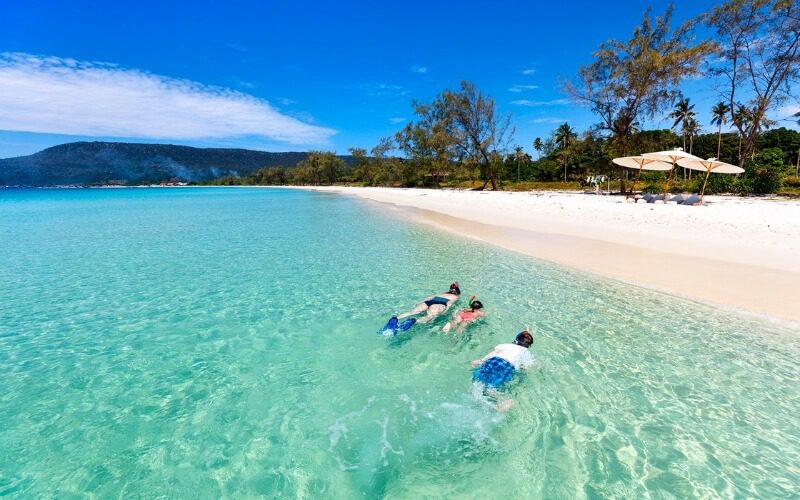
Family relax in Koh Rong, Cambodia
Visiting Koh Rong, Cambodia, is an experience that transcends the ordinary, offering travelers a slice of paradise with its pristine beauty and tranquil ambiance. This enchanting island, known for its dazzling white sandy beaches and crystal-clear turquoise waters, provides a serene escape from the bustling world. Koh Rong’s appeal lies not only in its natural beauty but also in the variety of experiences it offers. From snorkeling and diving among vibrant coral reefs teeming with marine life to trekking through lush jungle trails, the island caters to both adventure seekers and those looking to unwind in nature’s lap.
Moreover, Koh Rong’s nights are magical, with bioluminescent plankton lighting up the shores, creating a starry effect in the water that is truly mesmerizing. The island also boasts a range of accommodation options, from eco-friendly bungalows to luxury resorts, ensuring every traveler finds their perfect retreat.
Koh Rong’s combination of untouched natural beauty, adventurous activities, and the opportunity for relaxation makes it an essential stop on any Cambodian itinerary, promising memories that will last a lifetime.
Step 4: Plan Your Detailed Cambodia 6-Day Itinerary
Itinerary 1: 6 days in Cambodia Travel Throughout the Country
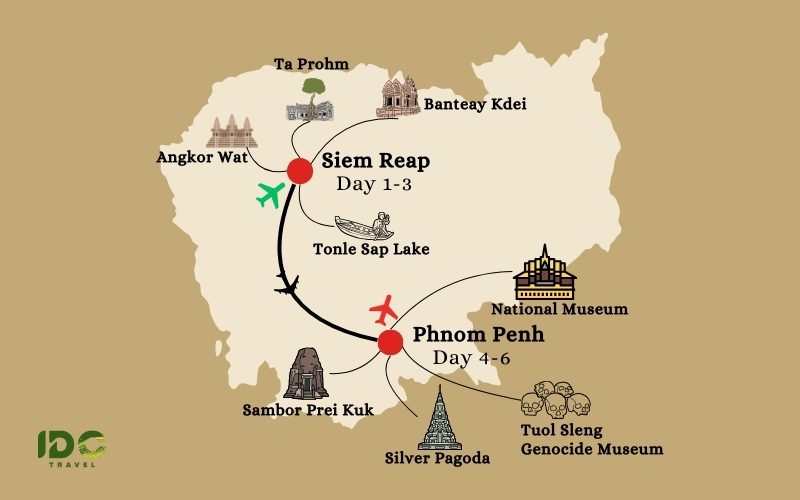
6 days in Cambodia Travel Throughout the Country
Day 1: Arrive in Siem Reap.
Day 2: Discover the Angkor Temple Complex, including Ta Prohm, Banteay Kdei, and Angkor Wat.
Day 3: Enjoy a jeep tour of Cambodia’s countryside, visit a Cambodian local family, and discover Tonle Sap Lake. Watch the sunset over this biggest freshwater lake in Cambodia.
Day 4: Transfer to Phnom Penh, stop to visit Sambor Prei Kuk temple in Kompong Thom and Skuon Market.
Day 5: Phnom Penh city tour on a tuk-tuk; visit the Silver Pagoda, Tuol Sleng Genocide Museum, and the National Museum in the morning. Afternoon enjoy a cycle tour around Phnom Penh’s countryside.
Day 6: Depart Phnom Penh.
>>> Discover all the best of Cambodia with this 6-day packaged tour.
Itinerary 2: 6 days in Siem Reap
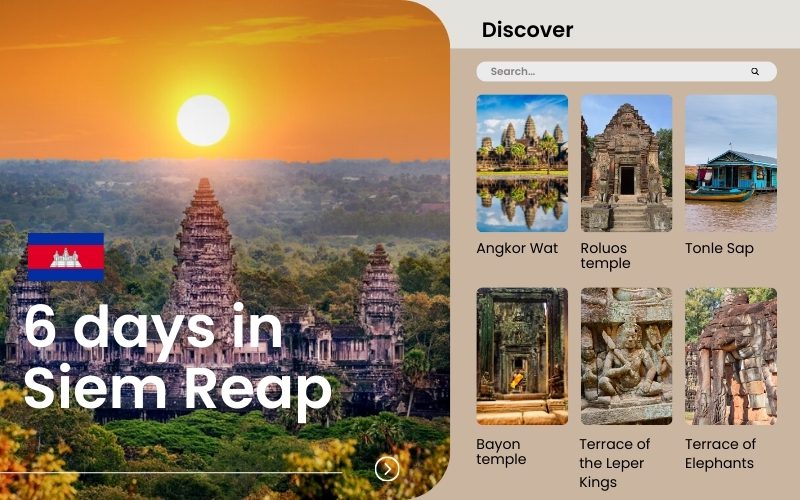
6 days in Siem Reap
Day 1: Arrive in Siem Reap, watch the sunset over the Angkor Wat temple, and enjoy a traditional Apsara dance performance
Day 2: In the morning, visit famous Angkorian temples, including some oldest temples in Roluos, and the temples of Preah Ko, Lolei, Bakong, etc. Dedicate your afternoon to discovering the Tonle Sap Lake, and take a boat trip to Kompong Phluck village on the lake.
Day 3: Watch the sunrise over Angkor Wat and explore the temple complex, from the South Gate to Bayon Temple, Phimeanakas, Preah Palilay, the Terrace of the Leper Kings, and the Terrace of Elephants.
Day 4: Explore the temples of the Grand Circuit, from Sra Srang to Pre Rup, Eastern Mebon, Ta Son, Neak Poan, and Preah Khan.
Day 5: Spend the whole morning discovering the temple of Banteay Srei (also known as the Citadel of the Women) and Pre Dak village. In the evening, watch a Cambodian circus performance called Phare.
Day 6: Depart Siem Reap.
>>> Click this link for the detailed itinerary of this package.
Which One to Choose?
Both itineraries offer a deep dive into Cambodia’s rich cultural heritage and natural beauty, but they cater to slightly different interests and experiences.
Similarities:
- Both itineraries start and end in Siem Reap, emphasizing the exploration of the Angkor Temple Complex, a testament to the grandeur of the Khmer Empire.
- Each itinerary dedicates significant time to exploring the temples, ensuring a comprehensive understanding of Cambodia’s historical and architectural marvels.
- Visiting Tonle Sap Lake, Southeast Asia’s largest freshwater lake, is included in both plans, offering insights into the unique lifestyle of communities living on the water.
Differences:
| Feature | Itinerary 1 | Itinerary 2 |
| Geographical Coverage | Covers both Siem Reap and Phnom Penh, including a transfer between the two cities. | Concentrated around Siem Reap and its surroundings, offering a deeper exploration of the area. |
| Cultural Experiences | Offers a variety of experiences including a jeep tour of the countryside, a visit to a local family, and a cycle tour around Phnom Penh. | Focuses on cultural performances such as the traditional Apsara dance and a Cambodian circus, alongside temple explorations. |
| Historical Sites Outside the Angkor Complex | Includes visits to Sambor Prei Kuk temple in Kompong Thom and Skuon Market. | Explores the temples of the Roluos group and Banteay Srei, known as the Citadel of the Women. |
| Urban vs. Rural | Balances between urban exploration in Phnom Penh with rural adventures in the countryside. | Leans more towards the rural and ancient aspects of Cambodia, with more time dedicated to temple exploration. |
| Activities | Mixes cultural, historical, and scenic activities with urban explorations and a broader look at Cambodia’s landscape. | Packed with historical and archaeological explorations, offering in-depth insights into Cambodia’s past. |
Which to Choose:
- Itinerary 1 is ideal for travelers who want a comprehensive Cambodian experience that includes both the country’s rural charm and urban dynamics.
- Itinerary 2 is better suited for those with a keen interest in archaeology, history, and Cambodian cultural performances, who prefer a focused exploration around Siem Reap.
Step 5: Pack your Luggage for 6 Days in Cambodia
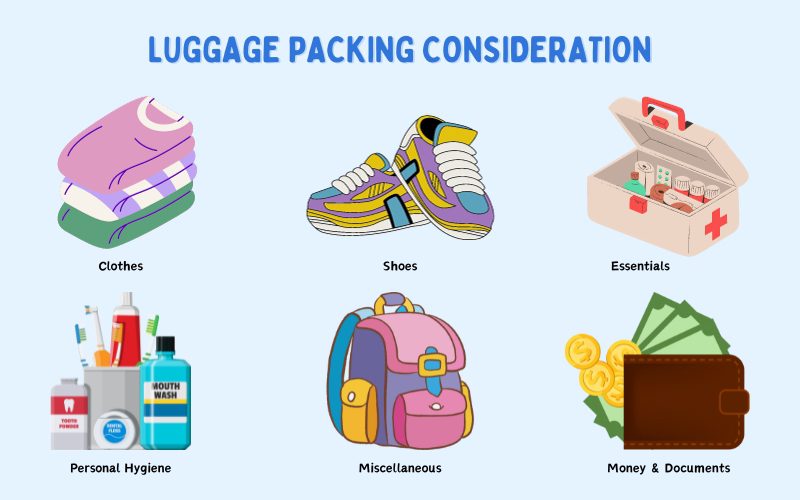
Luggage Packing Consideration
Packing for a trip to Cambodia requires considering the country’s warm climate, cultural norms, and the variety of activities you might engage in. Here’s a suggested packing list:
Essentials
- Passport with Visa: Ensure your passport is valid for at least six months beyond your stay. Check if you need a visa beforehand or if you can get one upon arrival.
- Travel Insurance: Opt for coverage that includes medical emergencies and unexpected travel changes.
- Local Currency (Cambodian Riel): USD is widely accepted, but having local currency is useful for small purchases.
- Copies of Important Documents: Keep digital and physical copies of your passport, visa, travel insurance, and itinerary.
Clothing
- Lightweight and Breathable Fabrics: Opt for cotton and linen clothes that are comfortable for hot and humid weather.
- Long Sleeves and Pants: Protect against the sun and mosquitoes, especially in rural areas or during temple visits.
- Conservative Attire for Temples: Cover shoulders and knees as a sign of respect.
- Comfortable Walking Shoes: Essential for exploring temples and cities. Consider bringing a pair of sandals for casual use.
- Rain Gear: A lightweight raincoat or umbrella, especially if traveling during the rainy season (May to October).
Health and Safety
- Insect Repellent: To protect against mosquito-borne diseases.
- Sun Protection: Sunscreen, sunglasses, and a wide-brimmed hat.
- Personal Medications: Plus a basic travel health kit including pain relievers, antidiarrheal medications, and band-aids.
- Hand Sanitizer and Wet Wipes: For times when water and soap aren’t readily available.
Gadgets and Accessories
- Power Adapter and Converter: Cambodia uses Type A, C, and G outlets, and the standard voltage is 230V.
- Portable Charger: Keep your devices charged while on the move.
- Water Bottle: Preferably one with a filter to reduce plastic usage and ensure you have access to clean water.
Miscellaneous
- Daypack: For daily essentials and souvenirs.
- Lightweight Backpack or Suitcase: Depending on your travel style and the length of your trip.
- Guidebook and Map: For historical context and navigating rural areas, digital versions can suffice.
Remember, packing light is key, especially if you plan to move around or take domestic flights with luggage restrictions. Adjust your list based on your specific itinerary, accommodations, and personal needs.
Above, we have given you the essential steps to plan a perfect trip to Cambodia in 6 days. This is a quite small country in Southeast Asia and about one week is normally enough to discover it all. From here, you can extend your trip to a nearby country like Thailand, Vietnam, or Laos for a more comprehensive experience of Southeast Asia. Don’t forget to check our well-planned Cambodia tours for more ideas. Or, contact us right now if you still have any questions or want a tailor-made trip to Cambodia.
Read more:
